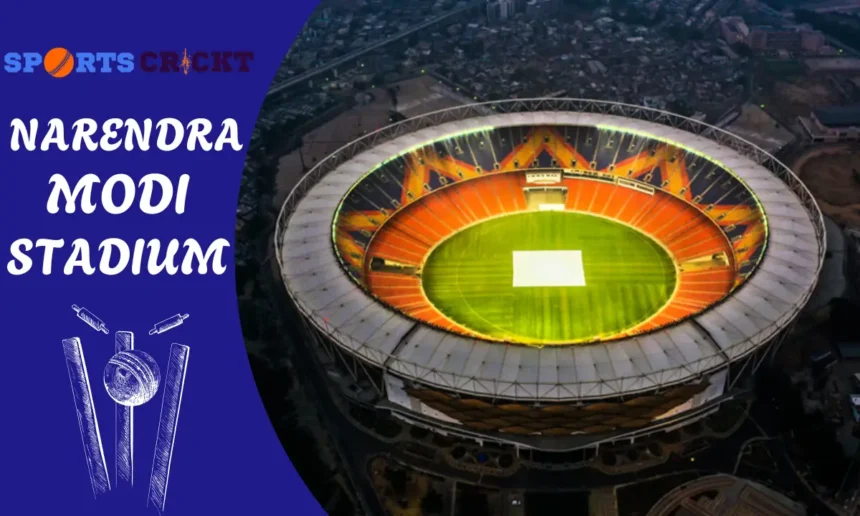In terms of size and space, the Narendra Modi Stadium is undeniably the largest cricket venue ever witnessed by the world. And, it is an honour for the prominent cricket playing nation of India to have this Stadium situated in Ahmedabad, Gujarat. Throughout history, many international cricket matches of different formats such as T20, ODI and Tests have been played here. On the other hand, many Indian Premier League (IPL) matches have also been organised at this stadium. Surely, this stadium occupies a lot of area which is efficiently utilised with the help of innovative architecture. A very good reputation is associated with the stadium in the world of modern sports architecture. It can even be referred to as a masterpiece.
As you may know, this stadium used to be formerly known as Sardar Vallabhbhai Patel Stadium. Under the initiative of the Modi government, this stadium was renovated, re-developed and renamed as the Narendra Modi Stadium. This is an elaborate blog covering every relevant detail about this cricket venue. For the same reason, it is highly recommended that you stay tuned to discover more information.
An Overview: Narendra Modi Stadium
As has been noted, this stadium is the largest in the world in terms of area acquired/utilised. Previously, this stadium was referred to as the Sardar Vallabhbhai Patel Stadium. Another name associated with this stadium is Motera Cricket Stadium. To give a tribute to Narendra Modi, Prime Minister of India this stadium was renamed as the Narendra Modi stadium in February 2021. Around 132000 Individuals can join in at once to encounter and spectate a cricket match here. Due to this huge capacity of spectators, the stadium is a very relevant venue for popular cricket matches to be organised. A total attendance of 101566 individuals is the record high at this venue.
Its versatility for different formats of cricket is pretty evident. This stadium is located in the Motera region of Ahmedabad, Gujarat, India. For the spectators, the nearest and most convenient public transits include Modi Stadium bus stop along with Motera Stadium station. The Vallabhbhai Patel International Airport is around 10 kilometres away from this venue. Additionally, a parking capacity of around 13000 vehicles is available for those who commute by personal vehicles. The Gujarat Cricket Association is the owner of this cricket stadium and handles all of its operations. Moreover, 76 executive suites in total are included for convenience of stay.
Narendra Modi Stadium – pitch Condition
According to sources, Populous has had major contributions behind the development and design of this stadium. Basically, it is an iconic sports venue designing firm. Formerly, Populous has worked on the prominent Wembley Stadium. Populous certainly made sure to equip the Modi stadium with the best facilities possible for a cricket venue. There are many factors which make the stadium as relevant as it is. The main reasons behind the stadium being an masterpiece are mentioned below:
- For any sports venue, a huge emphasis is put on the spectators’ comfort and experience. Here at this stadium the spectators get a 360 degree uninterrupted view of the ground.
- On the other hand, an appropriate and sufficient amount of LED floodlights have been established in place. Consequently, the shadows on the ground get reduced by a huge margin. The main reason behind this is that the designers didn’t choose to install traditional Tower lights. Instead, they went with the LED flood lights which are a more practical option.
- Organising back to back cricket matches is very convenient at this stadium because a total of 4 dressing rooms have been included.
- As you may know, rain often causes delay in cricket matches and sometimes even leads to the match getting cancelled. A very powerful and reliable drainage system has been installed at the Modi stadium. It ensures that the match gets continued as quickly as possible after rain.
Narendra Modi Stadium – Venue History
According to sources, the surface of the ground here is referred to as Bermuda grass. You will get to understand the pitch in more depth ahead. Further, this stadium has an oval-shaped field and ground. The successful establishment and opening of this stadium took place on November 12, 1983. From 12th November 1983 to 16th November 1983, the first ever test cricket series was played here between the national cricket teams of India and West Indies. Meanwhile, the first ODI match ever played here was on October 5, 1985. India and Pakistan competed against each other at this venue on December 28, 2012. This was the first T20 match to be organised here.
Narendra Modi Stadium – pitch Report
The pitch and field included on the stadium is very different from other venues as it is very versatile. During encounters, a variety of different situations and conditions unfold on the pitch. The favorability on the pitch depends on the cricket format as well as the weather. Two types of soils are available on the pitch of this stadium including red soil pitch and black soil pitch. Both of these pitches have distinctive characteristics consequently behaving differently depending on different factors during gameplay. A lot of complexity is added to a cricket encounter with this pitch. The impact of different weather conditions on the pitch is undeniable. The condition of the pitch at this stadium tends to change with the season of the weather. For example, the red soil pitch becomes extremely dry during hot weather adding a swing to the bowling of pacers. Whereas, the winters impact the pitch in terms of moisture. Let’s discuss the two different pitches elaborately:
- The red soil pitch is known to favour an effective bounce in the ball. Moreover, it is also very favourable for pacers. The red soil pitch gets dried out pretty quickly as it doesn’t absorb moisture. Consequently, cracks being developed in the pitch is a pretty usual phenomenon. In addition, some unpredictable spin balls are witnessed due to these dry cracks in the pitch. The fast bowlers can take advantage of the less amount of moisture in the soil. As the game progresses and some time passes, the pitch starts offering a good grip for deliveries to the spinners.
- In contrast, the black soil pitch takes a lot of time to dry out because it holds more moisture and for much longer periods of time. There is very little to no favorability for bounce while bowling. Spinners can certainly benefit from the moisture in the pitch soil. Lastly, the gameplay becomes much more complex and challenging for the players as the game progresses. This is because the pitch acts up because of rough gameplay.
Narendra Modi Stadium – Stats & Records
| First test series | November 12-16,1983 (India vs West Indies) |
| Last test series | March 9-13, 2023 (India vs Australia) |
| First ODI match | October 5,1985 (India vs Australia) |
| Last ODI match | February 12, 2024 (India vs England) |
| First T20I match | December 28, 2012 (India vs Pakistan) |
| Last T20I match | February 1, 2023 (India vs New Zealand) |
| First WODI | March 12, 2012 (India vs Australia) |
| Last WODI | October 29, 2024 (India vs New Zealand) |
| First WT20I | January 22, 2011 (India vs West Indies) |
| Last WT20I | January 24, 2011 (India vs West Indies) |
Conclusion
Being the largest cricket stadium in the world it certainly stands out from the rest. Having a huge spectator capacity makes the stadium very ideal and preferable for cricket encounters between popular teams. In the coming future, more cricket matches will be organised in this legendary cricket venue. Hence, its popularity will continue to grow.
Also read:- Ahmedabad Stadium Pitch Report Batting or Bowling
FAQs
Who is the owner of this stadium?
Gujarat Cricket Association
When was this cricket stadium established?
1983
What is the name of the nearest airport?
Sardar Vallabhbhai Patel International Airport
When was the first test series initiated here?
November 12, 1983





